Gestalt Principles: How We Organize What We See

Gestalt principles are rules that explain how our brain organizes stimuli. These principles help us understand why we see things the way we do. They revolve around the idea that the whole is something more than the sum of its parts.
A few psychologists established these principles, including researchers from the Gestalt Therapy Institute of Cologne such as Max Wertheimer, Wolfgang Kohler, and Kurt Koffka. These psychologists worked in a lab to demonstrate how the human brain organizes the information and images it sees throughout the day.
Thus, these new Gestalt principles replaced the idea that sensations are the result of a simple sum of individual pieces or images. As we said, these principles state that the whole is more than the sum of its parts.
Simplifying our world
The fact that we can interpret images in terms of meaningful units illustrates one of perception’s main processes. Its job is to try to simplify the complex stimuli that the environment presents to us.
If our brains didn’t reduce those complex stimuli to something more understandable, the world would be too much of a challenge for us to do our tasks adequately. Ironically, psychologists discovered that the process of simplifying the world requires a considerable perceptual effort on the brain’s part.
Perception gives meaning to the world
Let’s take a look at the following images:
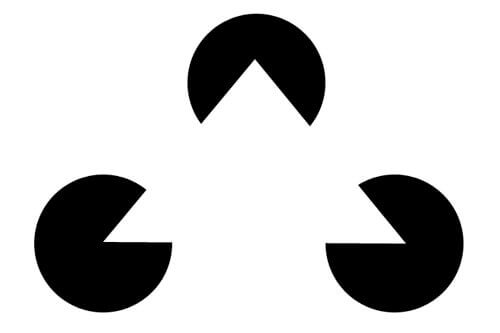
Most of us would say that we see an incomplete image in the picture above.
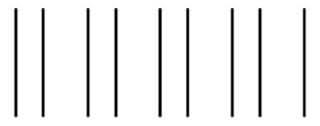
We could also say that you can find four tubes in the picture above.
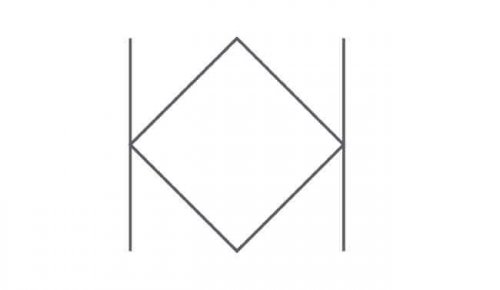
In the previous figure, we can see a square or diamond inside two lines.
Are those the only interpretations that we can come up with? One person, with all their thoughts and ideas, could argue that there are three angles in the first figure. There are eight vertical lines in the second and a “W” over an “M” in the third.
The Gestalt idea of perception emphasizes how we interpret individual elements of a scene as a complete and unified whole. This conception is based on the assumption that the organized whole is somewhat different and in fact larger than the sum of its individual parts.
Gestalt principles of grouping
Basic perceptual processes operate according to a series of principles. These principles describe how we organize chunks and proportions of information into meaningful units.
These processes are called the Gestalt principles of grouping. A group of German psychologists dedicated to studying patterns put these principles forth in the early twentieth century. They managed to discover valid principles of importance for visual and auditory stimuli. Here are those principles:
Closure
This principle dictates that we usually group in terms of closed or complete figures, rather than open figures. Therefore, this means that we tend to ignore discontinuities and concentrate on general shapes.

Proximity
We tend to group elements that are close to one another. As a result, we tend to see letters instead of single dots, like in the following image:
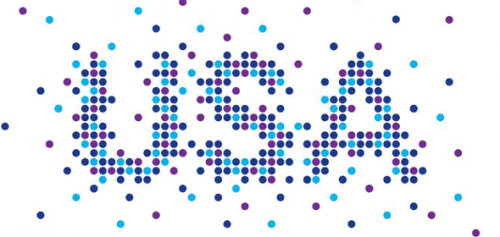
Similarity
We tend to group elements that share a similar appearance. This is why we see rows of identical apples instead of columns of different figures in the following image.
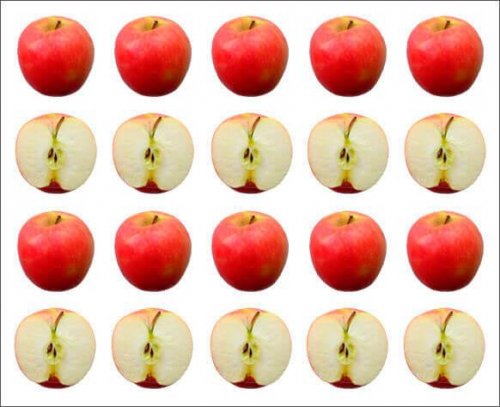
Simplicity
In a general sense, the predominant Gestalt principle is the law of simplicity. When we observe a pattern we perceive it in the most basic and direct way possible.
In the following image, we can see the watch hands as a Y. This happens in compliance with the principle of simplicity in which the brain “sets” what’s easier to understand.
When surrounded by the picture of the other letters, our brain is telling us that the spokes are creating the letter Y. However, the law of proximity is also at play since the pieces making up the Y are among other letters. We can also think about the principle of similarity because the colors in the image are the same and there are no curved lines.

As we can see, these Gestalt principles are extremely important if we want to understand how we perceive images. We organize stimuli in such a way that we give images meaning according to these different principles. This explanation is based on the fact that the brain needs to simplify what it perceives in order to make it more understandable.
This text is provided for informational purposes only and does not replace consultation with a professional. If in doubt, consult your specialist.








